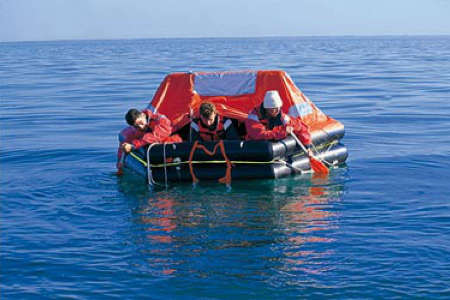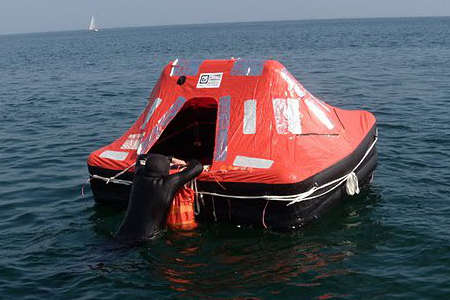Liferafts are inflatable floating modules equipped to enable collective survival at sea in a confined space. They can accommodate 4 to 12 people and are one of the key elements dedicated to navigation safety.
The capacity of a liferaft must match the number of people on board a vessel, including the skipper. These crafts should be chosen according to the type of navigation planned.
Mandatory liferaft types for recreational sailboats (excerpt from the updated Division 240, 2017)
In France and the European Union, liferafts are mandatory on recreational boats navigating more than 6 miles from a shelter* (see the updated Division 240 by the Ministry of Transport, which defines mandatory equipment for recreational boats).
*Official definition of "shelter":
A coastal location where any craft, boat, or ship and its crew can find safety by anchoring, landing, or docking and can depart without assistance. This concept takes into account current weather conditions as well as the characteristics of the craft, boat, or ship.
Official liferaft standards
The new ISO 9650 standard has harmonized liferaft design on an international scale. It distinguishes between two types of liferafts:


Type 1 liferafts (ISO 9650-I standard) are intended for offshore navigation (more than 60 miles from a shelter). They are designed to withstand strong winds and high waves.
This category of liferafts is divided into Group A (inflation temperature from -15 to 65°C, double floor) and Group B (inflation temperature from 0 to 65°C, single floor).
It is up to the skipper to choose the liferaft that suits their navigation plan. For example, if not navigating in icy waters such as Alaska, Svalbard, or Patagonia, a Group B liferaft is sufficient.
All Type 1 liferafts can be equipped for rescue waits shorter or longer than 24 hours. This choice also depends on the skipper.
These liferafts include the following equipment:
- Access ramp
- Minimum surface area per person of 0.372 m²
- Automatically inflating arch upon activation
- Liferafts designed for rescue waits longer than 24 hours are sold with a separate waterproof bag (grab bag) to store water, food, medicine, etc.
Type 2 liferafts (ISO 9650 Type II standard) are designed for coastal or semi-offshore navigation (6 to 60 miles from a shelter) and use at temperatures from 0 to 65°C, in moderate wind and sea conditions.
Liferafts must be serviced every 3 years, and annually after 15 years.
However, annual servicing is recommended after 10 years.
The case of tropical regions
The lifespan of liferafts may decrease in hot, humid conditions. For this reason, manufacturers in tropical areas require annual servicing of liferafts. It is therefore advisable to follow this measure during extended stays in these regions.
Liferafts can be packed in a bag or a rigid container. While the bag is easier to store, the container provides better protection against weather and mechanical damage (friction, accidental punctures, etc.). The container typically weighs around 3kg.
A liferaft must always be easily deployable into the water. For this reason, it is always stored outside the boat, either on the deck or at the stern.
Liferafts are equipped with a strap that is easily accessible upon removal from the bag or container. Start by securely attaching this strap to the boat. Then, throw the liferaft into the water. When the strap tightens, it activates a compressed air cylinder, which triggers the automatic inflation of the raft.
Once the crew is aboard the liferaft, never forget to cut the strap, as failure to do so could result in being dragged underwater with the boat if it is sinking.
Coastal or offshore liferafts can be found starting at around 1000 euros (base price).
The company Infornav organizes safety and liferaft handling training courses in La Rochelle.
World Sailing (formerly ISAF) courses also include a program for preparing for survival at sea.
Liferafts are inflatable floating modules equipped to enable collective survival at sea in a confined space. They can accommodate 4 to 12 people and are one of the key elements dedicated to navigation safety.
The capacity of a liferaft must match the number of people on board a vessel, including the skipper. These crafts should be chosen according to the type of navigation planned.
Mandatory liferaft types for recreational sailboats (excerpt from the updated Division 240, 2017)
In France and the European Union, liferafts are mandatory on recreational boats navigating more than 6 miles from a shelter* (see the updated Division 240 by the Ministry of Transport, which defines mandatory equipment for recreational boats).
*Official definition of "shelter":
A coastal location where any craft, boat, or ship and its crew can find safety by anchoring, landing, or docking and can depart without assistance. This concept takes into account current weather conditions as well as the characteristics of the craft, boat, or ship.
Official liferaft standards
The new ISO 9650 standard has harmonized liferaft design on an international scale. It distinguishes between two types of liferafts:


Type 1 liferafts (ISO 9650-I standard) are intended for offshore navigation (more than 60 miles from a shelter). They are designed to withstand strong winds and high waves.
This category of liferafts is divided into Group A (inflation temperature from -15 to 65°C, double floor) and Group B (inflation temperature from 0 to 65°C, single floor).
It is up to the skipper to choose the liferaft that suits their navigation plan. For example, if not navigating in icy waters such as Alaska, Svalbard, or Patagonia, a Group B liferaft is sufficient.
All Type 1 liferafts can be equipped for rescue waits shorter or longer than 24 hours. This choice also depends on the skipper.
These liferafts include the following equipment:
- Access ramp
- Minimum surface area per person of 0.372 m²
- Automatically inflating arch upon activation
- Liferafts designed for rescue waits longer than 24 hours are sold with a separate waterproof bag (grab bag) to store water, food, medicine, etc.
Type 2 liferafts (ISO 9650 Type II standard) are designed for coastal or semi-offshore navigation (6 to 60 miles from a shelter) and use at temperatures from 0 to 65°C, in moderate wind and sea conditions.
Liferafts must be serviced every 3 years, and annually after 15 years.
However, annual servicing is recommended after 10 years.
The case of tropical regions
The lifespan of liferafts may decrease in hot, humid conditions. For this reason, manufacturers in tropical areas require annual servicing of liferafts. It is therefore advisable to follow this measure during extended stays in these regions.
Liferafts can be packed in a bag or a rigid container. While the bag is easier to store, the container provides better protection against weather and mechanical damage (friction, accidental punctures, etc.). The container typically weighs around 3kg.
A liferaft must always be easily deployable into the water. For this reason, it is always stored outside the boat, either on the deck or at the stern.
Liferafts are equipped with a strap that is easily accessible upon removal from the bag or container. Start by securely attaching this strap to the boat. Then, throw the liferaft into the water. When the strap tightens, it activates a compressed air cylinder, which triggers the automatic inflation of the raft.
Once the crew is aboard the liferaft, never forget to cut the strap, as failure to do so could result in being dragged underwater with the boat if it is sinking.
Coastal or offshore liferafts can be found starting at around 1000 euros (base price).
The company Infornav organizes safety and liferaft handling training courses in La Rochelle.
World Sailing (formerly ISAF) courses also include a program for preparing for survival at sea.